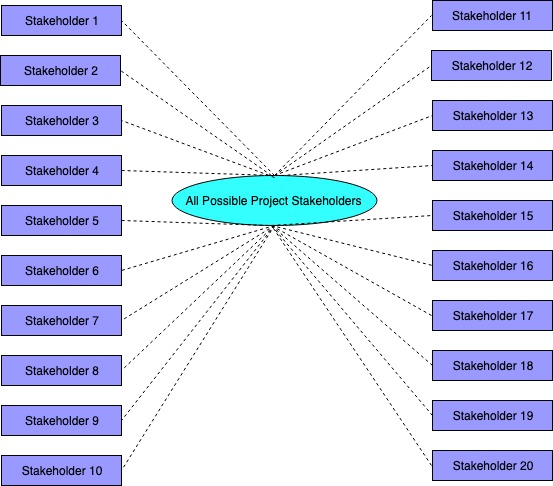Stakeholder Management Processes in Projects
Fraino12345 (Talk | contribs) (→Stakeholder Analysis) |
Fraino12345 (Talk | contribs) |
||
| Line 3: | Line 3: | ||
A stakeholder manager is an essential element for a prosperous project, program or portfolio. A stakeholder is an individual who will or can be affected by the aforementioned aspects. Thus, stakeholder management considers how the relationship between stakeholders can be affected and what processes can mitigate altercations. Stakeholder management processes are fundamental through businesses, organisations and projects, a set of strategies were developed to analyse stakeholders. The goals for the stakeholder management processes are to: | A stakeholder manager is an essential element for a prosperous project, program or portfolio. A stakeholder is an individual who will or can be affected by the aforementioned aspects. Thus, stakeholder management considers how the relationship between stakeholders can be affected and what processes can mitigate altercations. Stakeholder management processes are fundamental through businesses, organisations and projects, a set of strategies were developed to analyse stakeholders. The goals for the stakeholder management processes are to: | ||
| − | * Maximise supportive stakeholder engagement | + | * Maximise supportive stakeholder engagement in projects |
* Ensure the processes are understood by all stakeholders | * Ensure the processes are understood by all stakeholders | ||
* Introduce multiple key principles and processes for different stakeholder situations | * Introduce multiple key principles and processes for different stakeholder situations | ||
Revision as of 10:05, 12 February 2019
Abstract
A stakeholder manager is an essential element for a prosperous project, program or portfolio. A stakeholder is an individual who will or can be affected by the aforementioned aspects. Thus, stakeholder management considers how the relationship between stakeholders can be affected and what processes can mitigate altercations. Stakeholder management processes are fundamental through businesses, organisations and projects, a set of strategies were developed to analyse stakeholders. The goals for the stakeholder management processes are to:
- Maximise supportive stakeholder engagement in projects
- Ensure the processes are understood by all stakeholders
- Introduce multiple key principles and processes for different stakeholder situations
Contents |
Stakeholder Identification
Before the management can begin with multiple processes within a project, an identification is essential. The identification includes an initial brainstorm investigating all stakeholders who are potentially affected by any decision throughout the project. Stakeholders can be businesses, companies, individuals or educational industries; therefore, spending a sufficient amount of time on the identification process is fundamental. The following questions should be asked during the brainstorming session to embark on the identification process:
- Who is the suppler of the project?
- Who is the customer?
- Who influences the main stakeholders?
- Who can be affected by the project?
- Who is working towards solving the project?
- Who has the decisions over resources?
- Who is ultimately in charge of the success of the project?
Once these questions have been answered, the stakeholders can be classified and analysed.
Stakeholder Analysis
Once the identification process is clear and all stakeholders are found and named, the stakeholder analysis can begin. The analysis looks at an in depth classification of individuals in order to find the most relevant for certain situations. One method is the Power/Interested Grid. By classifying each stakeholder by power over work or interest over work.
- High power, interested people: these are the people you must fully engage and make the greatest efforts to satisfy.
- High power, less interested people: put enough work in with these people to keep them satisfied, but not so much that they become bored with your message.
- Low power, interested people: keep these people adequately informed, and talk to them to ensure that no major issues are arising. These people can often be very helpful with the detail of your project.
- Low power, less interested people: again, monitor these people, but do not bore them with excessive communication.
A second process for stakeholder analysis is by using four parameters:
1. POWER. Stakeholder’s authority level
2. INTEREST. Concern regarding the project outcomes
3. INFLUENCE. Active involvement in the project
4. IMPACT. The ability to effect changes to planning or execution
